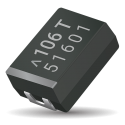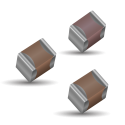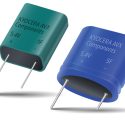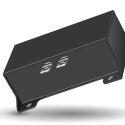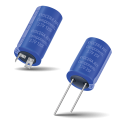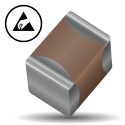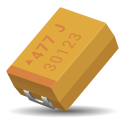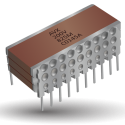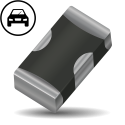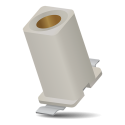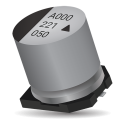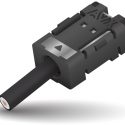Polymer Solid Electrolytic Capacitors for Automotive Applications Written By: Jaroslav Tomasko | Slavomir Pala Abstract: Tantalum electrolytic capacitors are constructed using a sintered pellet of powdered tantalum as the anode of the device. A grown oxide layer on the contoured surface of the pellet acts as the dielectric insulator, and a cathode terminal is formed using either a conventional MnO2 electrolyte or a conductive polymer to sufficiently contact the oxide layer. The final capacitor can be packaged in many forms, and the typical J-lead surface mount construction is shown in Figure 2. The capacitive structure is bonded to a molded case and electrically interfaced using carbon as a separation layer and silver for connection with the lead frame.
Technical Articles / Whitepapers
Analysis of the DC Blocking Capacitor for Stereo High-Fidelity Audio Written By: Rick Liu Abstract: The representation of audio signals in analog and digital electronics can take many forms. Still, they must ultimately be converted back to their mechanical origins as the motion of air molecules propagating as waves. These waves are generated by moving a mass, often the cone of a speaker, back and forth around a neutral position. As such, any fixed offset in the audio signal, represented by a DC bias, is simply a waste of energy and possibly a source of imbalance in the resulting sound wave. Series blocking capacitors are generally used for each audio channel to eliminate the potential of any DC component. While
Variability and Tolerance of Ceramic Capacitors Written By: Robert Lu Abstract: The multi-layer ceramic capacitor (MLCC) is one of the most common capacitor varieties found in electronic design. It offers a wide range of bulk capacitance and voltage tolerance in numerous form factors at relatively low cost. While these devices have become commonplace in the designers’ tool chest, they exhibit some often overlooked peculiarities. Of primary concern is the sensitivity of effective capacitance to several environmental factors, including temperature, applied bias voltage, and age. If these factors are unaccounted for, the risk of product failure becomes very real, especially in manufacturing variability and overall tolerance stack-up.
Platform Structure Clock Oscillators Written By: Toshihiko Koyanagi Abstract: Numerous devices in people‘s lives today are becoming more sophisticated. As a result, the number of crystal devices installed is increasing. For example, with the evolution of autonomous driving, we are using crystal devices for many functions such as sensor systems to detect distance, camera systems to capture images, image processing systems to process captured images, and communication systems to communicate many of those digital data in and out of the vehicle at high speed. In addition, in the network market, the number of crystal devices is increasing along with the further increase in the speed of communication devices, as well as the increase in the frequency and precision. This paper
SuperCapacitor Improvements on Small Generator Power Quality Written By: Ron Demcko | Ashley Stanziola | Daniel West Abstract: To expand portable electronics usage/reach/offering, the renewable power industry has taken an interest in the worldwide awareness of climate change and electronic waste, specifically how batteries affect the environment. One advancement is the emergence of modern low power hand crank generators, which roughly coincides with the accelerating interest in green energy used in portable electronics.
Predicting Metal Film Capacitor Lifetime Using Thermal Simulation Written By: Youssef Laamimat Abstract: In high-power applications like electric vehicles (EVs), customized metal film capacitors are often required to meet energy demands in a specific form factor. These capacitors exhibit a strong temperature dependence of their bulk capacitance over time, which directly limits their total service life. To maximize lifetime while minimizing space requirements, it is important to include accurate thermal simulation as part of the design process to ensure optimized and evenly distributed heat generation.
SuperCapacitors: A Reliable Backup Power Solution Written By: Johnson Jiang Abstract: Electric double-layer capacitors (EDLCs) are electrochemical capacitors called “SuperCapacitors,” or supercaps, due to their high energy density. Compared to traditional electrolytic capacitors, SuperCapacitors store electrical energy about two to three orders of magnitude higher and achieve several hundred thousand to millions of charge-discharge cycles. This advantage comes from the special construction of SuperCapacitors.
Electrostatic Protection Using Ceramic Capacitors Written By: Oliver Zimmermann | John McCarry Abstract: Any conductive interface between an electrical circuit and the outside world introduces the possibility of damage through electrostatic discharge (ESD). Accumulated static charge on a person, a cable, or any similar surface can readily dissipate its stored potential energy upon contact into sensitive components resulting in highly destructive currents. Ideally, varistors and TVS diodes only activate to protect the circuit when a high voltage is present and impart no parasitic effects during normal operation. For high-speed data lines, in particular, it is critical that the protection device introduce as little capacitance as possible (Electronic Design). TVS diodes and varistors are therefore specified not only by their voltage
High-Performance Battery Contacts for Mobile Electronics Written By: Ajay Saini Abstract: KYOCERA AVX offers the broadest standard battery connector line available on the market today. These robust connectors, available in horizontal and vertical options, are suited for battery pack integration and general board-to-board connection.
Tantalum Capacitors in 5G Smartphone Applications Written By: Jason Liu Abstract: The global smartphone market has grown enormously over the past decade. In 2019, about 1.32 billion smartphones were shipped globally, of which 367 million units were shipped in China alone, accounting for 27.8% of the global total. With the ongoing investment into the construction of 5G networks, especially in China, 5G-enabled smartphones are set to become ubiquitous in the near future. 5G phones are projected to grow by 10% starting in 2020 compared to the previous year. Under favorable economic and regulatory conditions, there will be ample opportunities for both leading and emerging manufacturers to capture more market share. Additionally, there are several design houses for smartphones that design
Key Parameters for Designing Ceramic Capacitors in SMPS Circuits Written By: Kevin Cho Abstract: Capacitors are ubiquitous and indispensable components of electronic circuits used for a plethora of uses. For engineers looking to design multilayer ceramic capacitors (MLCCs) in switch-mode power supplies (SMPS) such as Buck and Boost converters, some essential parameters to be considered include the ripple current capability, ripple voltage, and power dissipation. Using the KYOCERA AVX SpiCalci10 model simulation tool for SMPS capacitors, this whitepaper will outline various MLCC characteristics, AC current capability, and other considerations for circuit design.
Advantages of Varistors and Their Applications in the Automotive Field Written By: George Zhang Abstract: Multilayer chip varistors (MLVs) are resistive elements comprising zinc oxide (Zn0) as the main component. In recent decades, they are being used for protection against surge voltage, noise, and transient voltages. Unlike conventional varistors, the maximum peak current and non-linear coefficients are large, and the resistance is very high below a threshold voltage, hardly allowing current to flow. However, when the voltage exceeds the threshold, the resistance drops abruptly and allows a large current to flow. Such properties make MLVs ideal as protective elements in a host of electrical and electronic applications, including automobiles
Vertical Wire-To-Board Solutions for Solid State Lighting and Industrial Applications Written By: Raul Saucedo | Jon Schifferdecker Abstract: Solid-state lighting (SSL) and industrial applications often must overcome more stringent constraints on environmental tolerance and physical form factor. Primarily, thermal issues of heat dissipation and high-temperature reliability. One popular solution to address these issues is the use of metal core circuit boards.
Aluminum Capacitors for LED Lighting Written By: Raul Wang Abstract: While relatively expensive, LED lighting is more reliable, more configurable, and uses significantly less electrical power for the same luminous output when compared to its incandescent, fluorescent, and halogen counterparts.
IDC Shark Fin Connectors for RF Communications Written By: Alex Guan Abstract: Shark fin antenna units offer an attractive, aerodynamic, and functional way to provide the necessary antennas to the vehicle systems. RF antenna systems use coaxial cables, and the most common method to connect those cables to the printed circuit board assembly in the shark fin antenna is manual soldering.
SuperCapacitors in Enterprise Servers and Smart Meters Written By: Jacky Cui | John Lee Abstract: The supercapacitor is one alternative to the traditional electrochemical battery for storing energy. In the age of lithium-ion (Li-ion) batteries, supercapacitors offer many attractive properties that no other device can deliver. At a high level, supercapacitors are composed of electrodes, an electrolyte, and an ion-permeable separator.
